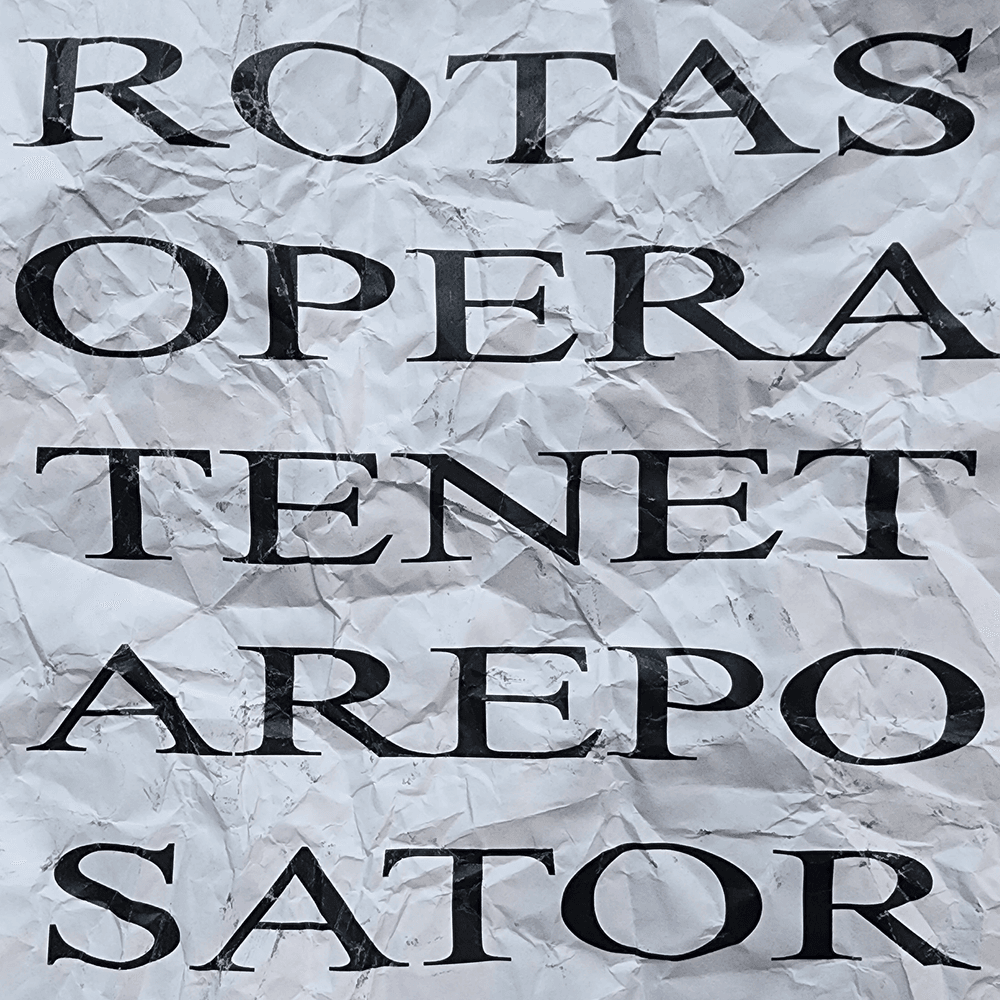

MATERIALS USED ARE TYPICAL PRINTER FEED PAPER FOR A HP LASER PRINTER AND A MODIFIED TIMES NEW ROMAN FONT TO RECREATE THE SQUARED SHAPE OF THE ORIGINAL TABLETS.
AS PER WIKIPEDIA: "The Sator Square (or the Rotas-Sator Square, or the Templar Magic Square) is a two-dimensional acrostic class of word square containing a five-word Latin palindrome.[1] The earliest squares were found at Roman-era sites, all in ROTAS-form (where the top line is "ROTAS", not "SATOR"), with the earliest discovery at Pompeii (and also likely pre-A.D. 62).[a] The earliest square with Christian-associated imagery dates from the sixth century.[b] By the Middle Ages, Sator squares had been found across Europe, Asia Minor, and North Africa.[1][2] In 2022, the Encyclopedia Britannica called it "the most familiar lettered square in the Western world".[3]
A significant volume of academic research has been published on the square, but after more than a century, there is no consensus on its origin and meaning.[1][4][5] The discovery of the "Paternoster theory" in 1926 led to a brief consensus amongst academics that the square was created by early Christians, but the subsequent discoveries at Pompeii led many academics to believe that the square was more likely created as a Roman word puzzle (as per the Roma-Amor puzzle), which was later adopted by Christians. This origin theory fails to explain how a Roman word puzzle then became such a powerful religious and magical medieval symbol. It has instead been argued that the square was created in its ROTAS-form as a Jewish symbol, embedded with cryptic religious symbolism, which was later adopted in its SATOR-form by Christians.[1][2][6] There are many other less-supported academic origin theories, such as: a Pythagorean or Stoic puzzle, a Gnostic or Orphic or Italian pagan amulet, a cryptic Mithraic or Semitic numerology charm, or that it was simply a device for working out wind directions.[1]
The square has long associations with magical powers throughout its history (and even up to the 19th century in North and South America), including a perceived ability to extinguish fires, particularly in Germany. The square appears in several early and late medieval medical textbooks such as the Trotula, and was employed as a medieval cure for many ailments, particularly for dog bites and rabies, as well as for insanity, and for relief during childbirth.[1][2]
It has featured in a diverse range of contemporary artworks including fiction books, paintings, musical scores, and films,[5] and most notably in Christopher Nolan's 2020 film Tenet.[7] In 2020, The Daily Telegraph called the Sator Square "one of the closest things the classical world had to a meme".[8]"
IN HONOR OF THE FIRST MEME

- 価格米ドル価格数量有効期限送信元
- 価格米ドル価格数量最低価格差有効期限送信元
MATERIALS USED ARE TYPICAL PRINTER FEED PAPER FOR A HP LASER PRINTER AND A MODIFIED TIMES NEW ROMAN FONT TO RECREATE THE SQUARED SHAPE OF THE ORIGINAL TABLETS.
AS PER WIKIPEDIA: "The Sator Square (or the Rotas-Sator Square, or the Templar Magic Square) is a two-dimensional acrostic class of word square containing a five-word Latin palindrome.[1] The earliest squares were found at Roman-era sites, all in ROTAS-form (where the top line is "ROTAS", not "SATOR"), with the earliest discovery at Pompeii (and also likely pre-A.D. 62).[a] The earliest square with Christian-associated imagery dates from the sixth century.[b] By the Middle Ages, Sator squares had been found across Europe, Asia Minor, and North Africa.[1][2] In 2022, the Encyclopedia Britannica called it "the most familiar lettered square in the Western world".[3]
A significant volume of academic research has been published on the square, but after more than a century, there is no consensus on its origin and meaning.[1][4][5] The discovery of the "Paternoster theory" in 1926 led to a brief consensus amongst academics that the square was created by early Christians, but the subsequent discoveries at Pompeii led many academics to believe that the square was more likely created as a Roman word puzzle (as per the Roma-Amor puzzle), which was later adopted by Christians. This origin theory fails to explain how a Roman word puzzle then became such a powerful religious and magical medieval symbol. It has instead been argued that the square was created in its ROTAS-form as a Jewish symbol, embedded with cryptic religious symbolism, which was later adopted in its SATOR-form by Christians.[1][2][6] There are many other less-supported academic origin theories, such as: a Pythagorean or Stoic puzzle, a Gnostic or Orphic or Italian pagan amulet, a cryptic Mithraic or Semitic numerology charm, or that it was simply a device for working out wind directions.[1]
The square has long associations with magical powers throughout its history (and even up to the 19th century in North and South America), including a perceived ability to extinguish fires, particularly in Germany. The square appears in several early and late medieval medical textbooks such as the Trotula, and was employed as a medieval cure for many ailments, particularly for dog bites and rabies, as well as for insanity, and for relief during childbirth.[1][2]
It has featured in a diverse range of contemporary artworks including fiction books, paintings, musical scores, and films,[5] and most notably in Christopher Nolan's 2020 film Tenet.[7] In 2020, The Daily Telegraph called the Sator Square "one of the closest things the classical world had to a meme".[8]"